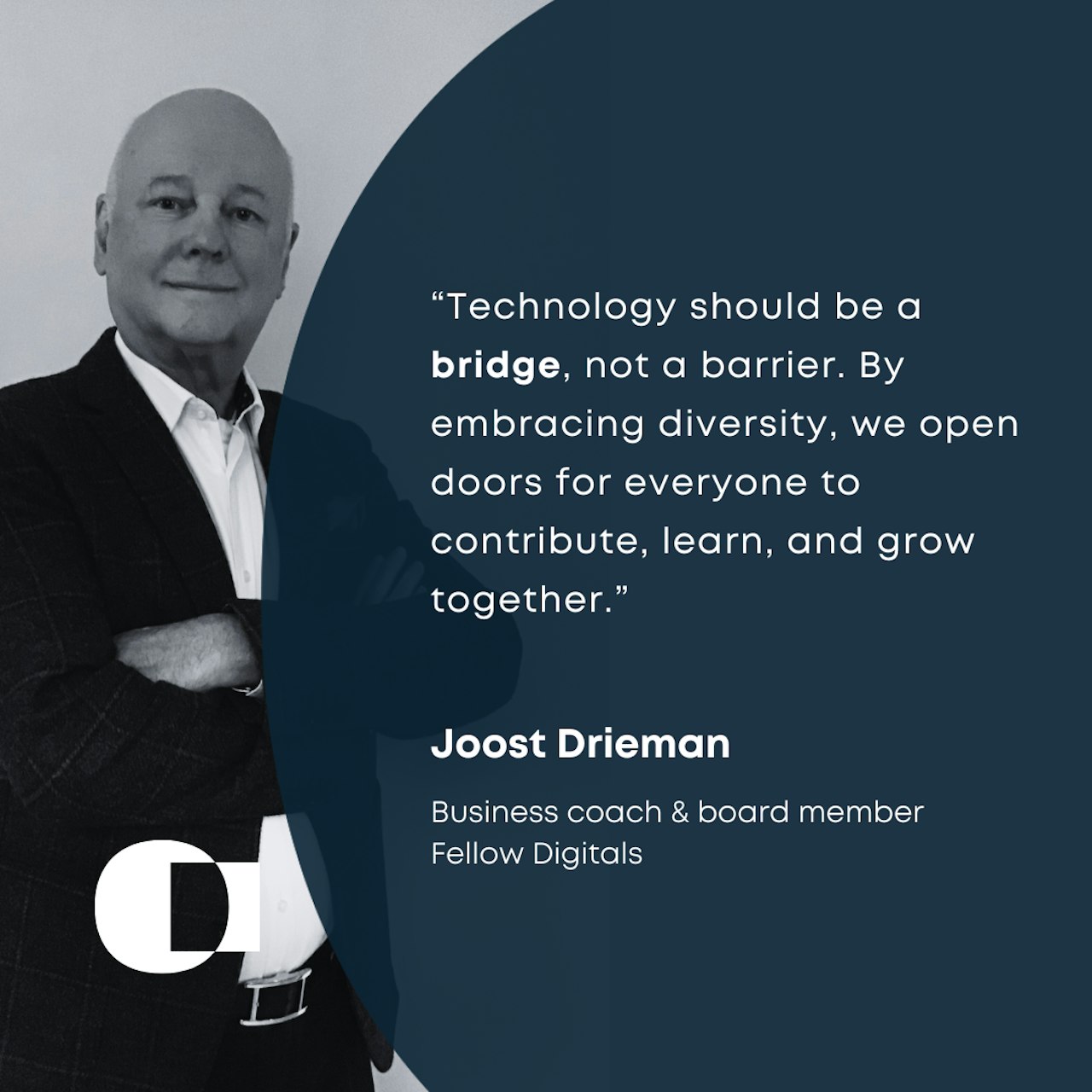Inclusive involvement: Bridging differences for a stronger company culture
Blog | Joost post series #14

In this episode of our “Joost Post” series, Joost Drieman, our seasoned business advisor and coach, explores a topic that’s central to any organization’s success: inclusion. Drawing on his vast experience in creating healthy work environments, Joost provides valuable insights on how embracing diversity—including disability—can ignite collaboration, innovation, and business growth.
A new kind of involvement: inclusion as a core driver
When we talk about involving everyone in a company, what does inclusion really mean, and why is it so crucial? Often, we think of diverse perspectives brought by people from different backgrounds, cultures, or generations . But one important aspect we might overlook is the inclusion of people with disabilities.
Inclusion is much more than simply accommodating employees with disabilities —it’s about creating an environment where their contributions are welcomed and valued. It’s about ensuring that everyone, regardless of their abilities, has the same opportunity to succeed, grow, and drive the company forward.
The (not so surprising) truth? When individuals from all walks of life, abilities, and perspectives come together, they offer unique skills and ideas that can truly transform a workplace. Inclusion isn’t just a “nice-to-have”—it’s a business imperative. Inclusive workplaces tend to be more innovative, productive, and, ultimately, more successful, as studies show. So, how can we ensure we’re tapping into this vast, underutilized resource?
The challenge of inclusion: from awareness to action
While many companies have begun making strides toward including people with disabilities, the next step is integrating inclusion into every part of daily life—beyond the acknowledgment stage.
True inclusion requires a mindset shift. It’s not about doing something for someone—it’s about doing something with them. This goes beyond ensuring physical accessibility; it’s about ensuring that every employee, regardless of ability, has a meaningful chance to collaborate, communicate, and contribute.
How does inclusive involvement help your business?
When you involve everyone, regardless of ability, your company will likely see improvements in various areas:
Boosted innovation: Diverse perspectives lead to new ideas. Individuals with disabilities bring unique problem-solving approaches that often spark creativity and innovation.
Stronger team dynamics: Teams are more adaptable and resourceful when they embrace diversity. Different experiences—whether related to disability, culture, or background—add richness to collaboration.
Improved employee engagement: A truly inclusive culture fosters loyalty. Employees who feel respected and valued are more likely to be engaged, productive, and committed to their roles.
Enhanced reputation: Companies that prioritize inclusion enjoy a competitive edge. They attract top talent, bolster their brand reputation, and experience higher retention rates.
Watch this powerful clip and see how an inclusive environment can score off a rival company:

Practical tips for bridging the inclusion gap
Now that we know inclusion’s importance, how do we actively foster an inclusive environment within the company? How can we break down barriers and make sure inclusion is more than just a concept, but a daily practice?
Start with awareness: Raising awareness about inclusion is essential. It’s not just about policies—it’s about helping employees understand the value of every person’s contribution.
Inclusive leadership: Leaders must lead by example, modeling inclusive behavior, fostering open dialogue, and engaging all employees. Inclusive leaders create a ripple effect throughout the organization.
Encourage open communication: Everyone must feel heard. Create a work environment where open, respectful communication is prioritized, ensuring employees are comfortable sharing ideas.
Provide flexibility and support: Flexibility is crucial for employees with disabilities to thrive. Whether through alternative work arrangements, accessible technology, or assistive devices, small adjustments can have a huge impact.
Foster peer support and mentorship: Pair employees from various roles or departments to promote understanding and collaboration. Cross-functional teams enable employees to collaborate and empower everyone to participate.
Celebrate all contributions: Every contribution counts in an inclusive culture. Recognize achievements from all employees—regardless of ability—to reinforce a sense of belonging.
The role of technology in supporting accessibility
Technology is meant to bring people together, but if it doesn’t account for varying needs, it can unintentionally isolate those with disabilities. By designing systems, tools, and platforms with accessibility in mind, companies can create a more inclusive digital experience, empowering all employees to contribute to the organization's success.
Some accessibility features to start with:
Higher contrast and customizable fonts: For employees with visual impairments, offering high contrast or adjustable font sizes can drastically improve the usability of intranet platforms and LMS.
Alt text for images and graphics: Alt text ensures that employees using screen readers can fully engage with visual content.
Avoiding flash or auto-playing videos: Multimedia content should be adaptable—allowing employees to pause, rewind, or turn off auto-play—especially for those with auditory or cognitive impairments.
Keyboard navigation: Make sure your systems are fully navigable using a keyboard, allowing employees with mobility challenges to interact seamlessly with the tools.
Transcriptions and captions for video/audio content: This is essential for employees who are deaf or hard of hearing, ensuring everyone can access multimedia content.
Screen reader-friendly design: Structuring content logically—using headings, lists, and labels—ensures smoother navigation for screen reader users.
The inclusion of these features isn’t just about compliance; it’s about ensuring everyone, regardless of their abilities, has an equal opportunity to contribute. By prioritizing accessibility in your intranet, learning management system, and other platforms, you’re breaking down invisible barriers and helping everyone perform at their best.
Conclusion: Embrace the full potential of your workforce
Inclusion is more than just a nice goal—it’s a critical business strategy that drives success, innovation, and growth. When every employee—regardless of ability—feels valued and heard, you create an environment where everyone is empowered to contribute, learn, and grow together. And that’s when your company can truly unlock its full potential.

We love to share our knowledge with you
Related blogs



